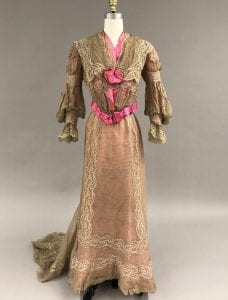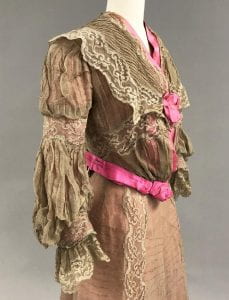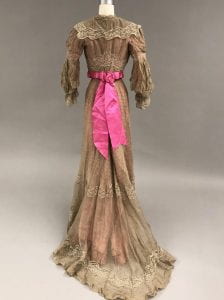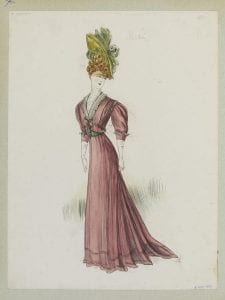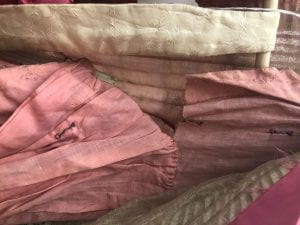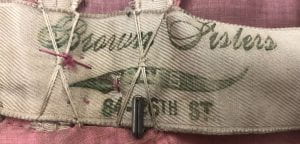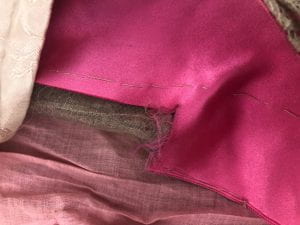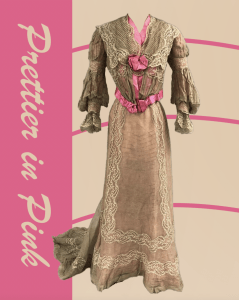This online blog post features materials protected by the Fair Use guidelines of Section 107 of the US Copyright Act. All rights reserved to the copyright owners.
Blog post by Ana Mocklar
When thinking of fashion from the late Victorian, early-Edwardian periods, chances are you don’t picture hot pink. While touring the Cornell Fashion and Textile Collection, I was struck by the vibrancy of the pink bow on a dress from the 1890s. This two– piece set is made up of a separated bodice and skirt (figures 1-3). Both pieces are made from a sheer, pin–tucked, tan overlayer and a pink cotton underlayer overlaid with a light tan lace. The bodice is beautifully accented by bright pink silk ribbons at the waist, in the center of the bust, around the neckline, and down the center back. The dress most likely functioned as a walking dress, displaying similarities to a “walking costume” design in 1906 (Victoria and Albert Museum).
Due to its lightweight and breathable materials, the tan and pink dress appears to be designed for the warmer months, lacking any insulating layers to protect from cold climates. The bodice also includes a built-in undergarment. This type of internal structure does include boning but does not act like a tight-lacing corset. The built-in chest support suggests that the dress was not meant to be worn with a corset underneath. This means that the garment’s measurements are most likely accurate to the wearer’s measurements. The connection between the bust and the upper chest is torn, suggesting that the fabric was having to support the chest rather than being able to rely on corsetry.
The connection between the chest and the upper undergarment has been repaired by hand stitching suggesting that the seam ripped during its period of use, rather than during its storage and corroborating the no-corset theory.
This piece was donated in 2020 by Olivia White, the great– granddaughter of Francis Anne Atherton White, the dress’ original owner. According to familysearch.org, Francis was born in 1822 in Ohio. She was a mother to eight children: four boys and four girls. In her adulthood she lived in Iowa, where she died in 1900 at the age of 78. Since the CF+TC dates the dress to the 1890s, Francis White was around 68 years old when she wore the dress. Her geographical locations throughout her life, known for their harsh and bitter winters, prove that her dress was meant for the summer months. Her life began in the early Victorian age, defined by the Cornell Fashion, Art, and Design Thinking class as 1820-1870, and ended at the cusp between Late Victorian/ Victorian dress reform movement and the Edwardian era, roughly 1870-1890 and 1890-1910 respectively. The dress is representative of its time period, featuring bishop sleeves, a looser bodice, and no corsetry. These characteristics reflect the Victorian Dress reform which occurred from the mid 1800s to the early 1900s. The skirt silhouette is more indicative of the late Victorian age, adapting an A line shape and a train, however does not include a bustle, which was an extremely popular feature in dresses in the first half of the late Victorian age. According to the Victoria and Albert Museum, the bustle went out of fashion around 1888, and the lack of a bustle dates the dress to around the 1890s, again corroborating the dates given by the CF+TC.
According to the Smithsonian National Museum of American History, “By the 1890s both men and women were able to buy off-the-rack clothing in department stores.” Francis White’s dress was most likely one of these ready-to-wear pieces of clothing. The label on the interior tag mentions a physical location at 84-26th Street.
The address on the tag might suggest the presence of a physical store, atelier, or workshop. Produced by the Brown Sisters, the garment is almost entirely machine sewn. Without the invention of lace machinery and sewing machines, a dress like this wouldn’t have been affordable to most people, also distinguishing it from most pieces. The bodice alone contains around 100 pintucks, a feat that would have taken ages to do by hand, and multiple long strips of lace. However, the garment is not entirely machine sewn. Tacking stitches are used to hold pieces of silk ribbon in their correct placement.
It is possible that these stitches were done by Francis White in order to repair or better fit her garment. This inference is supported by the different thread color and strength that is used on this alteration. Although it is still possible that these stitches were done during production, the uneven stitching and differing thread type compared to the machine sewed parts suggests that this was an alteration done at home.
Perhaps the most standout feature of the dress has the most interesting history. The stunningly pink accent ribbons could not have been achieved without the invention of aniline dyes. The first aniline dye was mauve, a purplish colored dye discovered accidentally by a chemist in 1856 (Cooksey). Three years later, Magenta aniline dye was invented. Since the dress was produced 25+ years after the invention of magenta aniline dyes and was most likely mass produced, we can infer that this dress was not dyed naturally. Further confirming this are records of magenta dyes in a report on aniline dyes shown at the French exhibition in 1867 (Reiman). This report dedicates an entire chapter to the science, observations, and recipes for magenta dye, establishing its importance at the time. The dyes bypassed the expense, inconsistency, and difficulties of using natural dyes, and, therefore, quickly found their way into the garment and textile industries. The vibrancy and consistency of the coloring prove that the garment was dyed with aniline dyes. The aniline dye theory is further supported by a cotton dye swatch chart dated by the Smithsonian library to 1900.
Both pinks featured in the dress are included on the dye chart. The interior pink fabric, which is made of cotton, matches the dye sheet perfectly. Although dyes look different on different fabrics, it is safe to say that the color of the silk ribbon is definitely possible through aniline dyes.
Francis Anne Atherton White’s tan and pink walking dress from CF+TC’s collection exemplifies the technological and societal advancements from the 1890s-1900s through its design and production. Although the vibrant pink is not commonly associated with the time period, the saturation of color indicates the use of aniline dye, an invention from earlier in the century. The use of 19th century technologies continues in the machine-made lace and the machine woven fabrics. Both inventions enabled for vibrant, ready-to wear clothing to be produced in the latest styles and colors. White’s walking dress is a product of the societal shift from made-to-wear to ready-to-wear. The rich history surrounding the dress makes the piece all the more beautiful.
Works Cited:
Cooksey, C., & Dronsfield, A. (2010, January 1). The battle for Magenta. RSC Education. Retrieved from https://edu.rsc.org/feature/the-battle-for-magenta/2020242.article
Cornell Fashion and Textile Collection. (2020). Dress, two-piece pink silk with overlay of tan sheer and lace. CF+TC Database. Retrieved from https://cornellfashion.pastperfectonline.com/Webobject/6577A114-F49A-419B-AE5E-154382024220
FamilySearch.org. (2022). Francis Anne Atherton White. FamilySearch.org. Retrieved from https://ancestors.familysearch.org/en/KN12-G7G/frances-ann-atherton-1822-1900
National Museum of American History. (2019, May 10). Ready-to-wear clothes. National Museum of American History. Retrieved from https://americanhistory.si.edu/visitor-guides/object-project/ready-wear-clothes
Reimann, M., Crookes, W., & Dean, J. (1868). On aniline and its derivatives: a treatise upon the manufacture of aniline and aniline colours. (Rev. and ed. / by William Crookes.). Kroch Library. New York: J. Wiley. Retrieved from http://catalog.hathitrust.org/Record/102203337
Smithsonian Library. (1970, January 1). Color in a new light. Smithsonian Libraries. Retrieved from https://library.si.edu/exhibition/color-in-a-new-light/making
Victoria and Albert Museum. (2009, June 30). Aladin: Jeanne Paquin: V&A explore the collections. Victoria and Albert Museum: Explore the Collections. Retrieved from https://collections.vam.ac.uk/item/O537629/aladin-fashion-design-jeanne-paquin/
Victoria and Albert Museum. (2013, March 28). Introduction to 19th-century fashion. Introduction to 19th-Century Fashion. Retrieved from http://www.vam.ac.uk/content/articles/i/introduction-to-19th-century-fashion/
Author Bio: Ana Mocklar is a freshman majoring in Fashion Management with intended minors in Business and Information Science/Data Analysis.

